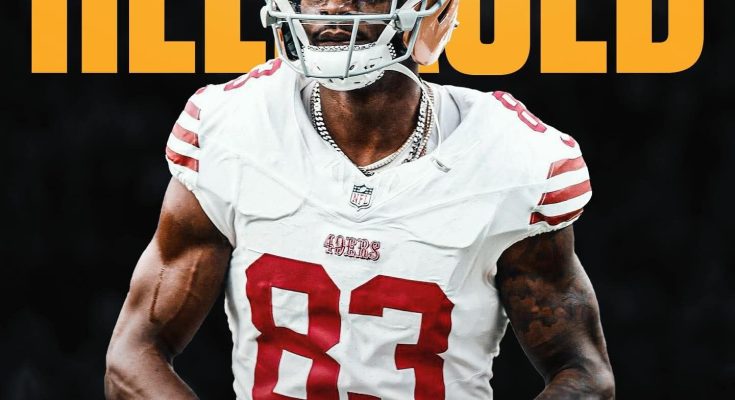Marquez Valdes-Scantling, a veteran wide receiver with seven seasons of NFL experience, finds himself at a familiar yet uncertain crossroads in his career following his recent release from the San Francisco 49ers. The move came as a result of an injury settlement after he suffered a calf injury that placed him on injured reserve. Now that he’s reportedly healthy, the 31-year-old receiver is free to sign with another team, and while his production this season was minimal—four catches for 40 yards over five games—there’s still a window, however narrow, for him to contribute again in the league.
The story of Valdes-Scantling has always been one marked by potential, flashes of brilliance, and a very specific skill set that NFL teams value but also treat with caution. Drafted in the fifth round in 2018 by the Green Bay Packers, he made his early name as a deep threat with rare speed, averaging over 17 yards per reception in his first few seasons. His ability to stretch the field vertically made him a favorite of quarterback Aaron Rodgers, especially in situations that demanded quick strikes and big plays. But inconsistency, both in hands and in route running, prevented him from becoming a top-tier receiving option. Even as he moved on to teams like the Kansas City Chiefs and now briefly with the 49ers, his reputation remained consistent: dangerous in space, capable of creating separation on go-routes, but unreliable as a week-to-week receiving staple.
When the 49ers added Valdes-Scantling to their practice squad late in the 2025 preseason, it was a low-risk move intended to bring depth and veteran savvy to a receiver corps that had battled injuries. The team elevated him to the active roster just days later, a sign that they believed he could provide immediate help, especially in stretching defenses and giving quarterback Brock Purdy another downfield option. But that hope never quite translated into significant impact. Over the five games in which he played, Valdes-Scantling was targeted sparingly and managed only four receptions for a total of 40 yards. For a player of his archetype, that stat line reflects either a lack of opportunity, a diminished role in the game plan, or an erosion of speed or burst that once made him dangerous.
His role in San Francisco’s offense was never clearly defined. The 49ers already featured established playmakers like Deebo Samuel, Brandon Aiyuk, and tight end George Kittle, all of whom command a significant share of the targets and offensive attention. With running back Christian McCaffrey also being heavily involved in the passing game, there simply weren’t many scraps left for a situational deep threat. Valdes-Scantling may have been insurance—there if needed—but not central to the 49ers’ offensive design.
Then came the injury. Calf strains are notoriously tricky for wide receivers, as they directly affect acceleration, cutting, and overall speed. For a player whose value hinges almost entirely on quick bursts and the ability to stretch the field vertically, even a minor calf issue can be enough to sideline their effectiveness. On October 17, 2025, the 49ers placed him on injured reserve. That move typically signals at least a four-week absence, but in this case, the team and player reached a settlement shortly after, which allowed him to be released from IR and seek opportunities elsewhere once healthy.
An injury settlement in the NFL is a procedural move that serves both parties. The team agrees to pay the player for a set number of games based on the estimated time they’ll miss due to injury. After that, the player is free to sign with any other team once deemed healthy. For Valdes-Scantling, this means that while his time in San Francisco ended with little fanfare, he’s not necessarily out of options. However, the market he’s entering is not the same as the one he found during the prime of his career.
At 31 years old, he is no longer the ascending player that teams might have been willing to develop. He is now considered a veteran journeyman. While his experience and deep-threat capability could still hold value for the right offense, teams will undoubtedly approach with caution. One reason is his recent lack of production. Four catches in five games is not enough to convince front offices that he can still be a difference-maker. Combine that with age, recent injury, and the evolution of offensive schemes that increasingly prioritize multi-dimensional receivers, and his landing spots become more limited.
Still, there is a potential path forward for him. Teams struggling with injuries at the wide receiver position or lacking in vertical speed might see value in bringing him in for workouts. His past success in playoff environments—particularly his stint with the Chiefs, where he made notable contributions in the postseason—adds a layer of credibility. Coaches and general managers often speak about the importance of “playoff experience,” and Valdes-Scantling can offer that. Additionally, as the NFL season progresses and teams move into the playoff push, veteran players who understand the rigors of late-season football are often called upon to fill depth roles.
Another angle is special teams. While Valdes-Scantling has not traditionally been a core special teamer, his size, speed, and experience could allow him to contribute in kick coverage or return units if needed. It’s not uncommon for aging receivers to extend their careers by becoming more versatile in their responsibilities. If he’s willing to take on that kind of role, he may make himself more attractive to teams looking to bolster not just their offense but their overall roster flexibility.
That said, whether or not he finds a team willing to give him a meaningful opportunity will depend largely on his ability to prove he’s healthy and capable of still playing at NFL speed. Private workouts, team visits, and perhaps even a willingness to start on a practice squad again may be in his near future. He has been through that route before, and he understands the work and patience required to climb back up the depth chart. Some teams may even be eyeing him as a post-Week 10 signing, when veterans signed do not have their full-year salaries guaranteed. That’s often a financial factor teams consider when bringing in older players.
Looking back on his career, Valdes-Scantling has played in over 90 NFL games and started more than half of them. His career receiving yards hover around the 3,000-yard mark, with over a dozen touchdowns to his name. His most productive year came in 2020 with the Packers, where he led the league in yards per reception and had multiple catches of over 40 yards. Since then, his role has diminished, especially in offenses that emphasized timing routes and intermediate passing more than vertical shots.
Even so, the role of a deep threat hasn’t disappeared in today’s NFL. Defenses are faster, more complex, and often built to stop quick passing attacks, which is why vertical threats who can take the top off coverage are still valued—even if only as decoys. If Valdes-Scantling can still run in the 4.4 range, there will always be some interest, particularly from offensive coordinators looking to stretch safeties and open up underneath lanes.
It’s also worth noting that sometimes, a change of scenery and situation can rejuvenate a player’s career. Should he land in a system with a quarterback who excels at throwing deep balls and a coordinator willing to design specific packages for him, he could still deliver impact plays. Teams like the New Orleans Saints, who have dealt with WR injuries, or even the Buffalo Bills, who have leaned heavily on their top receivers and might need depth, could be potential landing spots. These are speculative fits, of course, but they reflect the types of situations that tend to bring veterans back into the fold.
Ultimately, Marquez Valdes-Scantling’s journey is far from unique, but it is instructive. He represents a class of NFL player that hovers between starting-caliber talent and role-specific utility. In the right setting, with the right health and opportunity, he can still offer value. The next few weeks may determine whether that opportunity materializes. His physical tools haven’t necessarily disappeared, but the question remains whether those tools are still sharp enough to earn him another contract. If history is any indicator, the NFL isn’t quick to give up on players who have proven they can produce in high-pressure moments—especially those who bring veteran experience and professionalism to the locker room. For Valdes-Scantling, the clock isn’t done ticking, but the urgency is rising. He’s healthy, available, and potentially still useful. Now, it’s just a matter of finding the right fit before time—and the league—moves on without him.



